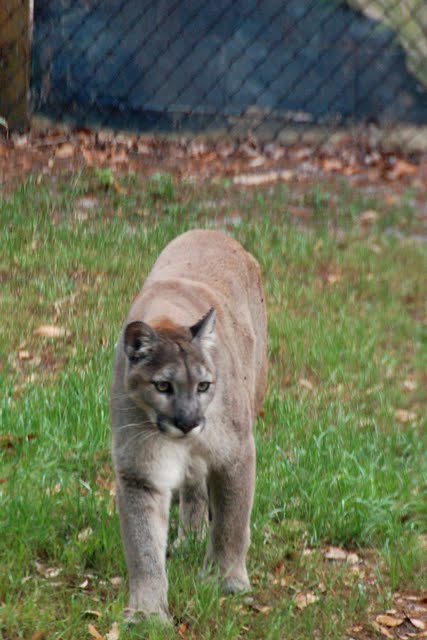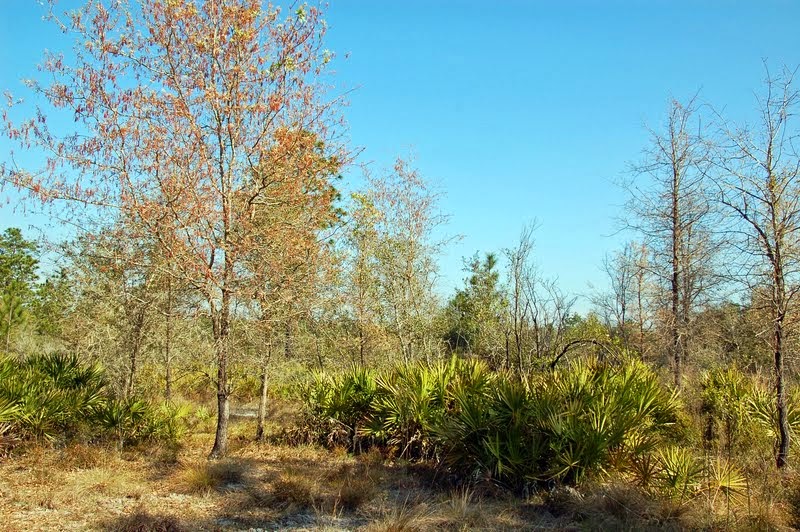A comprehensive history of the area going back to the civil war can be found here and is interesting reading although I won't reproduce it here :-). To sum it up, the Park's early history included a series of private owners who maintained tourist attractions on this site. The last private owner had plans to sell the land to a developer, but a grassroots effort generated by the county residents succeeded in gathering enough signatures on petitions to block the sale. The county purchased the park, and after running it for a few years, the State of Florida purchased the Park from Citrus County on January 1, 1989. This would preserve the land from any further threats of development.
As per Florida State Park directives, the management of the Park has shifted from entertainment to environmental education, and from the display of exotic animals to the protection and exhibition of native Floridian wildlife and plants. With one exception, which I will detail later.The Park encompasses 200 plus acres of land, and wetlands, hydric hammock areas and spring-fed springs are some examples of the diverse physical features of the Park. The centerpiece of the Park is a deep natural spring of the first magnitude that pumps out over a million gallons of water each hour. The water here is SO clear. To provide the best possible view of the spring, previous owners of the Park installed a floating underwater observatory in the main spring in 1964.
The headsprings
On a visit to the park back in February, I took this picture of Al and Cousin Bill and Cousin Bruce on the upper level of the observatory.
The springs here provided a refuge for the Park's captive-born West Indian Manatees, as well as a half-way house for rehabilitating manatees that are scheduled for release back in the wild. Last year the Park was host to four manatees that had become extremely sick from the red algae bloom that happened south of us. These manatees were successfully nursed back to health and released in the spring. I read a news report that 276 manatees died the winter and spring of 2013 from the red algae, and a total of 769 deaths from all causes This is a significant percentage of the population of approximately 5000.
The main visitor's center is on Highway 19. Many visitors do like to take the boat ride down Pepper Creek to the Park's entrance. This is the volunteer job that Al does here at the Park on Fridays and Saturdays, driving the boat and chatting to the guests about some of the Park facts. Its important to note here, that along Pepper Creek, any animals or birds that you see are strictly wild and can come and go as they please. There is a resident gator, Waldo, who lives under the boat dock and comes out quite often to sun himself on a small floating platform. If he wants to leave, though, he is free to go! Its funny how many guests ask Al if he's real!
I photographed these wood ducks here along Pepper Creek while taking the boat back to the visitor center. The Park has placed several wood duck boxes along the creek to attract them, but again, they are free to come and go. This time of year Al gets to see the little fluff balls of ducklings tumbling out of the boxes.
The Park calls itself home to many native animals, which varies as new members are introduced and others are released. Florida Black Bears, Whooping Cranes, Florida Panthers, Key Deer, Red Wolves, a Grey Fox, and American Alligators are some of the animals that present a showcase of past and present native Florida species. Most of the animals housed in the Park have been injured in some way, usually resulting from an encounter with humans.
The mammals are all victims of "human imprinting". This means they have spent their entire lives being cared for by people and/or have abandoned their fear of humans. They would be likely to fall victim to human cruelty, starvation, or cause some menace or danger to humans.
Maygar, who passed away this winter was an example of this. She was sold as a kitten to a family who wanted to have her as a pet. They had her spayed and declawed. When she became fully grown, and became a danger to the family and neighbors, she was turned into the Fish and Wildlife Service. Being declawed she had no way to feed herself, and being spayed presented a danger to her in that male panthers would not recognize her as a female and would attack her. So Maygar was unable to be rehabilitated into the wild, and found a safe home here at the Park.
These three river otters were found as babies when their mom was killed ( I do not know how). They were so small they had to be bottle-fed by hand, and so became accustomed to humans. They are permanent residents of the Park. However, last year older otters were found that did not need to be hand fed, and they were rehabilitated in the Felburn Building behind the park, with no guest interaction or human feeding They were subsequently released into the wild.
I don't have pictures of the Florida Black Bears, but there are two on exhibit in their habitat that had become accustomed to humans. The Park has successfully released many cubs back into the wild over the years. Many times we'll receive an email looking for volunteers to collect "natural bear food" and bring it to the Felburn building, to keep the bear cubs accustomed to eating their normal diet.
The birds of prey, many of the white and brown pelicans, shorebirds, the sandhill cranes and the female whooping crane were rendered flightless by wing injuries caused by vehicle collisions, utility wire tangles, fishing line entanglements, or even shot. All of the other birds in the Park, such as the blue herons, egrets, ibis, wood ducks, can fly but have made their home here, due to the abundance of food and security from predators.
There are three beautiful eagles, all with wing damage. Its very sad, as you can almost see it in their eyes how badly they want to be soaring free.
Another good story about our birds concerns the whooping cranes. Whooping cranes are critically endangered, with an all-time low population of only 15 recorded in 1941. They belonged to one flock that migrated between Wood Buffalo National Park in Canada and Aransas National Wildlife Refuge in Texas. Protection efforts succeeded in raising the population to 2014 in 2005. Not wanting all their cranes in one basket, so to speak, a small flock was successfully transplanted in Chassahowitzka National Wildlife Refuge in Florida. These whooping cranes, however, had absolutely no idea how to migrate, so a plan was hatched to teach them. The International Whooping Crane Recovery Team decided to use an ultralight aircraft as a tool to teach the young cranes the migratory route between Florida and Necedah national Wildlife Refuge in Wisconsin. You can read about it here.
Anyway, back to our Park. The Park had a male and a female whooping crane, both injured. The male, however, was mute, therefore unable to initiate mating, and the attempts to have any eggs was failing. A few years ago, the ultralight was guiding the flock down to Chassahowitzka, and flew over the Park. Whooping Crane tag#501 (aka "Levi") took a look down, saw the female, and thought she looked like one hot mamma. he left the flock, flew down into her enclosure, and decided to stay. The FWC came and collected him, taking him back to his flock. Levi promptly flew back to the Park. Again, he was retreived and returned to the flock. Meanwhile, the Park erected a temporary netting over the top of the whooping crane habitat. Not to be deterred, Levi flew back to the Park, stopped short of the netting, and proceeded to walk back to the apparent love of his life. At this point the officials decided it was a lost cause. The mute male was removed to a different park, Levi was allowed to stay, and there have been successful matings, although no hatched chicks yet. Oh, and he is also affectionately called "Romeo" now :-)
I have no pictures, but all of the snakes in the Park could be released and could survive. However, they are important educational ambassadors for their wild relatives. Many people have a great fear of snakes (such as yours truly) and tend to assume that every snake they see is venomous. By exhibiting all native venomous and many common non-venomous species, the Park provides a way for people to learn to identify them and learn how snakes benefit our environment. (Yes, I know all that, still don't like them and still don't want to be anywhere near one!
Lastly, the exception to the native species rule. Most everyone realizes that African Nile Hippopotamus are not native to Florida. Lu came with the Park when the state purchased it, and was one of the area's local movie stars (featured in Daktari and Cowboy in Africa). A grassroots effort again by the community resulted in the Governor of Florida making Lu and honorary Floridian, allowing him to remain in the Park as a permanent resident. Every year at the end of January, the Park holds a birthday party for Lu. Being an herbivore, a cake is made out of bread, and local schoolchildren are invited to attend his party and throw his cake to him. the local paper always covers the occasion, and there are cupcakes and juice served to all the partiers. Lu is 54 years old this year. Lu's birthday was January 26, 1960.
I hope this answered a lot of questions you may have about our beautiful park, and hope it encourages more of our winter visitors to come and see it next time they head over here, to the beautiful Nature Coast of Florida.



























































